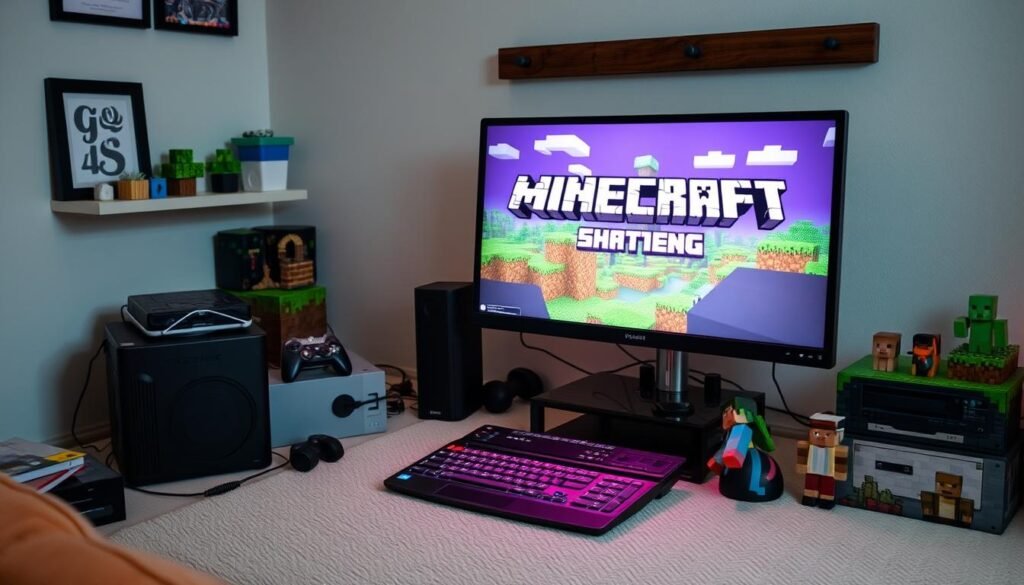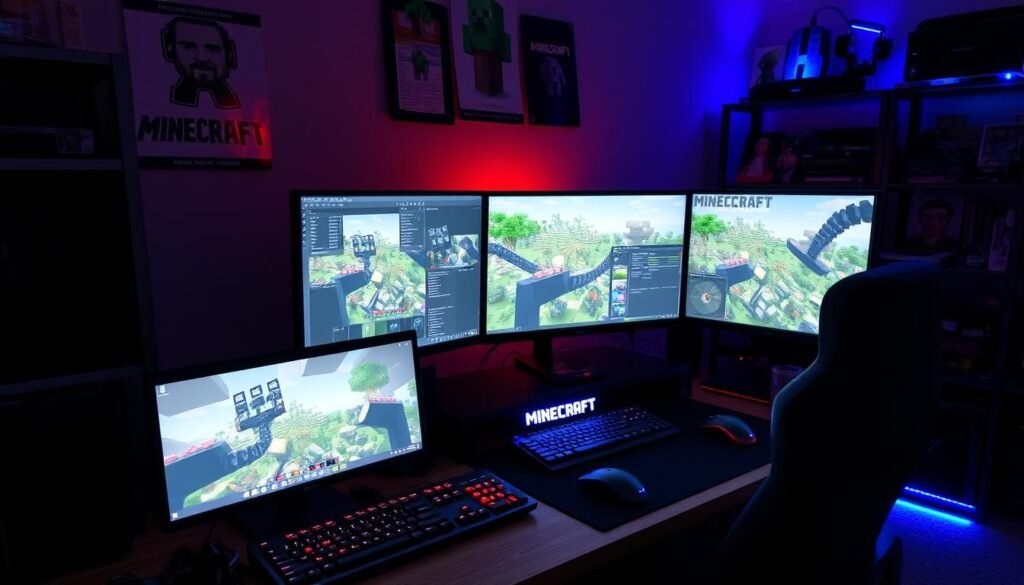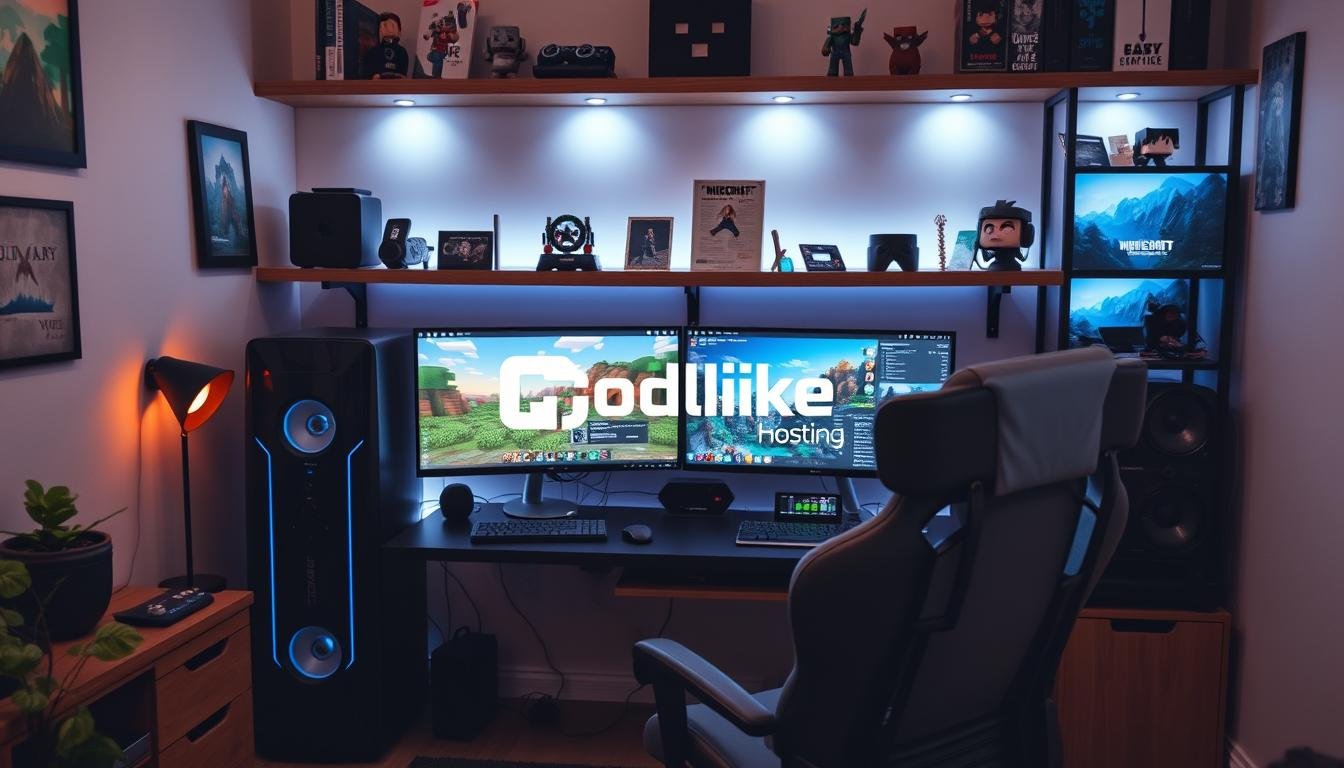Thinking about hosting a Minecraft server on your computer? With over 300 million copies sold, Minecraft is a huge hit. Hosting your own server lets you change the game in ways you can’t normally. It’s a fun way to share a unique Minecraft world with friends.
Hosting on your own PC can save you money. It’s cheaper than using a VPS hosting service, which is common for Minecraft servers.
To start, you need to know the basics. This includes how much RAM you need, based on players and world size. Also, a fast internet connection is key to avoid lag. For more info, check out domain hosting difference to learn about your online options.
Key Takeaways
- Hosting a Minecraft server on your home computer can be a cost-effective option
- A reliable home internet connection is required to avoid lag
- The recommended RAM for hosting a Minecraft server varies based on the number of players and world size
- Understanding the basics of hosting a Minecraft server is key for a great experience
- Hosting a Minecraft server on your own computer is part of minecraft server hosting
- Godlike Hosting is a top choice for reliable and efficient hosting
- Creating a Minecraft server lets you change the game in new ways
Understanding the Basics of Minecraft Server Hosting
Hosting a Minecraft server requires some knowledge. With over 300 million copies sold, Minecraft’s popularity has soared. This has led to a big need for servers where players can meet and play together.
To start a server, you need to know some basic computer and networking stuff. This includes port forwarding and what Java version you need.
One great thing about hosting a minecraft server is that you can change game settings and control who can do what. You can host on your home computer or use a service like Pine Hosting. This can make setting up your server quick, in just 15 minutes.
When how to host a minecraft server, think about how many players you’ll have. This will decide how much RAM and storage you need.
- Minimum Java version required for optimal server performance
- Recommended RAM and storage space based on the number of players
- Importance of port forwarding and TCP port 25565 for server accessibility
Knowing these basics helps you make a fun gaming space for you and your players. You can host at home or use a service. The main thing is to find a way that works for you and keeps your players safe and happy.
Essential Hardware Requirements for Home Hosting
When setting up a Minecraft server, having the right hardware is key. A self-hosted Minecraft server needs a desktop with a good processor, RAM, and storage. You’ll want at least a quad-core CPU, 16GB of RAM, and an SSD.
This setup is a good start. But, you might need to add more RAM, up to 32GB or more. This depends on how many players you have and how complex your game world is.
A fast SSD is vital for storing your Minecraft server files. It makes loading times much shorter and your game more responsive. Also, a reliable NIC that supports 1 Gbps or higher is needed for fast connections. A top-notch CPU, like Intel’s Xeon or AMD Ryzen, helps manage many players and heavy games.
- A minimum of 2 GB of RAM, with 4-16 GB recommended for larger servers
- A fast SSD with at least 10 GB of available space for world data, mods, and backups
- A stable internet connection with at least 10 Mbps upload speed
- A static IP address for the host machine to prevent connectivity disruptions
Investing in the right hardware lets you create a top-notch self-hosted Minecraft server. It offers a great gaming experience for you and your friends. Think about your needs and server size when setting up a Minecraft server. This ensures you have the right hardware for your gaming community.
Setting Up Your Computer for Hosting a Minecraft Server
To host your own Minecraft server, you need to prepare your computer. This means setting up your operating system, network, and port forwarding. A reliable computer with enough power is key for hosting a Minecraft server.
Make sure your computer meets the basic needs. It should have a 64-bit operating system, at least 2 GB of RAM, and a good processor. Check the official Minecraft website for the best system specs.
Here are some important things to think about for hosting your own Minecraft server:
- Operating System: Pick a 64-bit operating system, like Windows 10 or Linux, for a stable server.
- Network Configuration: Set up your network right to have a stable and safe connection. This includes port forwarding, usually on port 25565.
- Java Installation: Get the right version of Java, Java 8 for Minecraft 1.12 and up, for a smooth server setup.
By following these steps and considering these points, you can set up your computer for hosting a Minecraft server. You’ll have a great time playing with your friends.
| Server Type | Minimum RAM | Recommended Processor |
|---|---|---|
| Minecraft Bedrock Server | 1 GB | 2 CPU cores |
| Minecraft Java Edition Server | 2 GB | 4 CPU cores |
Downloading and Installing Minecraft Server Software
To host your own Minecraft server, you need to download the official Minecraft server software. It’s free and available on the official Minecraft website. This process is simple and usually takes just a few minutes. When you host a Minecraft server at home, you can control your server settings and customize your gameplay.
Here are the steps to download and install the Minecraft server software:
- Go to the official Minecraft website and download the Minecraft server software.
- Save the downloaded file to a folder on your computer, such as “Minecraft Server”.
- Open the folder and run the installation file to install the software.
After installing, you can start setting up your server. You’ll need to choose a server name, port number, and game mode. You can also add plugins and mods to customize your server. Minecraft server hosting lets you create a unique gaming experience for you and your friends.
Hosting a Minecraft server at home needs a good internet connection and enough RAM. You should have at least 4GB of RAM. Make sure your computer meets the system requirements, including a 64-bit operating system and a reliable internet connection.

By following these steps and considering the system requirements, you can easily download and install the Minecraft server software. Then, you can start hosting your own Minecraft server at home.
| Server Software | System Requirements | Recommended RAM |
|---|---|---|
| Minecraft Server Software | 64-bit operating system, reliable internet connection | 4GB |
Hosting Minecraft Server on Own Computer: Step-by-Step Guide
Hosting a Minecraft server on your own computer can be a fun and rewarding experience. To start, you need to know the basics of how to host a minecraft server. You also need a computer with enough resources. The steps include setting up the server, configuring properties, and testing it.
When hosting a Minecraft server on your own, think about the hardware needs and security risks. A bad internet connection can cause lag, making gameplay slow. Make sure your internet is stable and your computer has enough RAM and CPU.
To set up your server, you’ll need to adjust the server properties. This includes the max-players and difficulty level. You can also tweak settings to reduce lag and enhance gameplay. For instance, servers with 10 or fewer players use less than 20% CPU compared to the maximum.
Here are some key considerations when hosting a Minecraft server on your own computer:
- Ensure you have Minecraft Java Edition, as other versions do not support custom servers.
- Allocate sufficient RAM and CPU power to your server.
- Configure the server properties to optimize gameplay experience.
- Consider the possible security risks and take steps to protect your server.
Managing Server Performance and Resources
Setting up a minecraft server setup means thinking about performance and resources. A self-hosted minecraft server lets you control these aspects. This is key for a smooth gaming experience.
To keep your server running well, watch its usage, tweak settings, and fix problems. Keeping backups and updating regularly is also vital. Here are some tips to manage your server’s performance and resources:
- Monitor server usage to identify any issues
- Optimize server settings for better performance
- Troubleshoot common issues to minimize downtime
By following these tips, your minecraft server setup will run smoothly. This will give you and your players a great gaming experience. Don’t forget to think about the resources needed for your self-hosted minecraft server. This includes hardware and bandwidth to meet player demands.

| Server Type | Recommended Hardware | Recommended Bandwidth |
|---|---|---|
| Small Server | 2.8 GHz quad-core processor, 4GB RAM | 10 Mbps upload speed |
| Large Server | Server-grade CPU, 8-16GB RAM | 50 Mbps upload speed |
Security Measures for Home-Hosted Servers
Hosting a Minecraft server requires careful attention to security. It’s a fun and rewarding task, but it comes with challenges. One key step is setting up your firewall correctly. A good firewall blocks unauthorized access and attacks.
Keeping your server software updated is also vital. Updates fix vulnerabilities and stop exploits. Don’t forget to back up your server often. This helps you recover quickly if something goes wrong.
Here are some more security tips for hosting a Minecraft server:
- Binding your server to localhost to reduce the risk of unauthorized connections
- Encrypting connections between servers using VPN solutions
- Implementing strict firewall settings to block suspicious activities
- Setting limits on simultaneous connections from single IP addresses to prevent server overload
By taking these steps, you can keep your server safe and fun for players. Hosting a Minecraft server needs ongoing care and security focus. With the right steps, you can make a secure and enjoyable space for your players.
| Security Measure | Description |
|---|---|
| Firewall Configuration | Configuring your firewall to block unauthorized access and malicious attacks |
| Server Software Updates | Keeping your server software up to date to patch vulnerabilities and prevent exploits |
| Regular Backups | Keeping frequent backups of your server to recover quickly in case of downtime |
Troubleshooting Common Server Issues
When it comes to minecraft server hosting, fixing common server problems is key. With over 822,150 reads, many users seek solutions. Connection issues often stem from network, server, or client lag.
To tackle these problems, refreshing the server list or restarting your modem/router can help. Also, check for error messages like “Failed to login: invalid session (Try restarting your game)”. This might point to a server setup issue. If your server is slow, try using less RAM or tweaking settings.
Internet connection problems can also cause issues. Using a wired Ethernet connection can help. Limiting active connections on your network ensures your server gets enough bandwidth. These steps can make your host minecraft server at home experience better.
Also, check your FPS in the game with the F3 key or Fn + F3. Drops in FPS can mean performance issues. Keeping your video drivers up to date is also important. By doing these, you can fix common problems and enjoy smooth gaming with your minecraft server hosting.
Alternative Hosting Solutions with Godlike Hosting
Hosting a Minecraft server on your own computer has its challenges. Godlike Hosting offers a better way with their hosting plans. They cater to different needs, making it easy to set up your Minecraft server.
Godlike Hosting lets you choose from self-hosted, dedicated, or cloud-based servers. Their solutions are easy to use and reliable. They ensure your Minecraft server is always up and running smoothly, no matter your experience level.
Godlike Hosting includes routine backups and updates to keep your server safe and current. They also offer a free subdomain to save money. Plus, they suggest recommended domain registrars like GoDaddy and Namecheap for easy domain management.
Godlike Hosting has plans for every budget. Their flexible plans let you upgrade or downgrade as needed. This means you can have a high-performance Minecraft server without the stress of managing it yourself.
Godlike Hosting is a solid alternative to hosting your Minecraft server at home. They offer a variety of plans, an easy-to-use interface, and a focus on security and performance. It’s a great choice for a hassle-free Minecraft server setup.
Conclusion: Making the Right Choice for Your Minecraft Server
Minecraft has sold over 300 million copies worldwide. It’s a huge hit, known for its creativity and multiplayer fun. You can host your own Minecraft server or use a service provider. Hosting your own server lets you customize and create a special experience for you and your friends.
But, hosting a Minecraft server has its technical and cost sides. Buying a server from a provider can cost between $5 and over $100 a month. Setting up your own server might cost around $90, good for 1 or 2 players. Think carefully about these costs and needs to make sure everyone has a great time.
Choosing the right hosting and managing your server well can make a great Minecraft community. It’s fun for both new and experienced players. Hosting your own server can be a rewarding way to meet others and make lasting memories. So, start hosting your Minecraft server and explore new possibilities.
